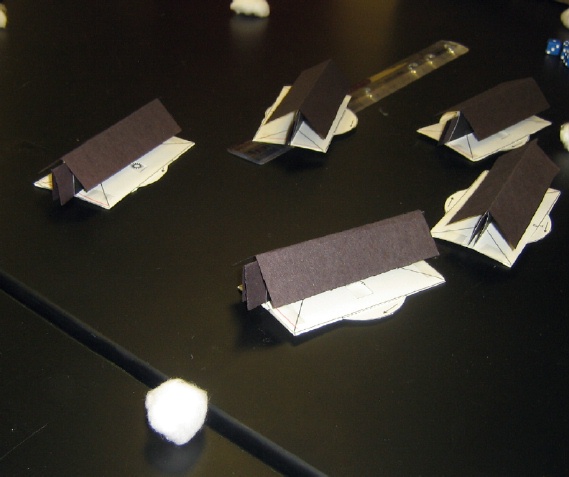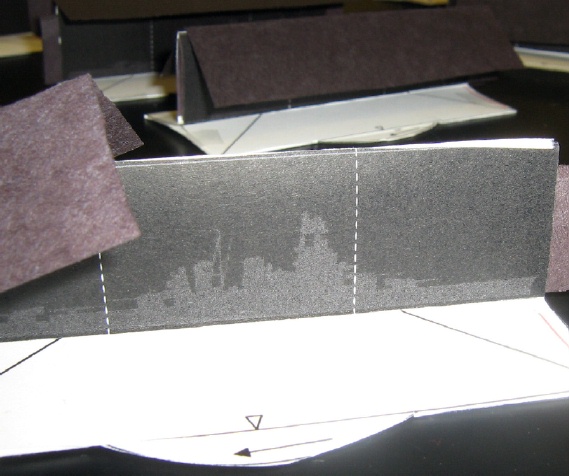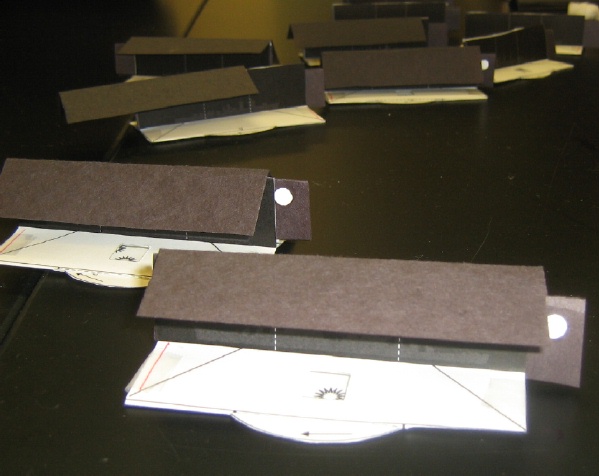“Brawl in the Dark” - Ironbottom
Sound and the Naval Battle of Guadalcanal, 1942
Fast Play Rules for Students
< Home
>
By Pete Pellegrino
(Naval War College)
 Background: November 1942, South
Pacific. The Imperial Japanese Navy has been tasked to deliver reinforcements
to Guadalcanal and support the offensive to retake the airstrip, Henderson
Field, from the US Marines. A task group of 14 Imperial warships is proceeding
south down “The Slot” between the Solomon Islands to bombard Henderson Field and
destroy the aircraft there in order to allow the slow, heavy army transports to
reach Guadalcanal safely. Thirteen US warships are steaming north through
Ironbottom Sound to intercept the Japanese. The two forces nearly collide with
one another in the pitch black night. Star shells, flares and searchlights
probe the darkness as ships intermingle and attempt to sort out friend from
foe. Blasting away at each other in confusion at close range, an officer on USS
Monssen likened it to “a barroom brawl after the lights had been shot out.”
Background: November 1942, South
Pacific. The Imperial Japanese Navy has been tasked to deliver reinforcements
to Guadalcanal and support the offensive to retake the airstrip, Henderson
Field, from the US Marines. A task group of 14 Imperial warships is proceeding
south down “The Slot” between the Solomon Islands to bombard Henderson Field and
destroy the aircraft there in order to allow the slow, heavy army transports to
reach Guadalcanal safely. Thirteen US warships are steaming north through
Ironbottom Sound to intercept the Japanese. The two forces nearly collide with
one another in the pitch black night. Star shells, flares and searchlights
probe the darkness as ships intermingle and attempt to sort out friend from
foe. Blasting away at each other in confusion at close range, an officer on USS
Monssen likened it to “a barroom brawl after the lights had been shot out.”
Playtest: As the two fleets
approached each other in darkness a starshell suddenly illuminated the Atlanta
at the head of the US task force. She was targeted by several Japanese
ships and left a flaming wreck in a flash. The American commander had
spotted a battleship amid the Japanese ships and he ordered his ships to destroy
the battleship at all costs. A well placed starshell lit up the Hiei and
she was pounded from all directions and destroyed. The Americans had also
noticed a second Japanese battleship firing at them, and she became their new
target. A strong force, led by the Portland, Juneau, and Helena headed in
to attack the Kirishima. One American destroyer, the Sterett, even tried
to ram the Kirishima but in the darkness she hit a Japanese destroyer instead.
The Laffey and Helena found the Kirishima in the chaos and illuminated her with
searchlights so the rest of the fleet could clobber her. Shells rained
down from all directions, and she was hit by at least one torpedo before
sinking. In the confusion two Japanese destroyers had accidentally
blundered into and joined a squadron of American destroyers. A starshell
revealed the mistake to both sides simultaneously. The Japanese reacted first,
sinking two American ships before racing off into the darkness. The very
confused captain of the Fletcher fired at what he thought was a Japanese
destroyer, but it was the O'Bannon that he sunk by mistake. The Samidare
was struck by two torpedoes and destroyed. At that point both sides
decided to withdraw. The Japanese had lost two battleships and five
destroyers. The American losses were a heavy cruiser, a light cruiser, and
four destroyers. It was an American victory.
- Imperial Japanese Navy
- 2 battleships: Hiei, Kirishima
- 1 light cruiser: Nagara
-
11 destroyers: Samidare, Murasame, Asagumo,
Teruzuki, Amatsikaze, Yukikaze, Ikazuchi, Inazuma, Akatsuki, Harusame,
Yudachi
-
- United States Navy
- 2 heavy cruisers: USS San Francisco,
Portland
- 3 light cruisers: USS Helena, Juneau,
Atlanta
-
8 destroyers: USS Cushing, Laffey, Sterett,
O’Bannon, Aaron Ward, Barton, Monssen, Fletcher
Setup: Two 7.5’ by 5’ tables should
provide ample space for this tight, close-in battle. Arrange IJN ships in the
northwest corner, steaming southeast. Deploy the USN task group in the
southeast corner, headed northwest.

The simulation uses special ship pieces designed
to mask the identities of the ships and replicate some of the challenges of
night fighting. Click for ship templates and assembly instructions in a single
PowerPoint file (USN-IJNShipKit.ppt) or
in a single Adobe PDF file (USN-IJNShipKit.pdf),
or here for the individual pages as JPEG files:
Instructions1.jpg, Instructions2.jpg,
Instruction3.jpg,
HitWheelsjpg,
SearchlightTabs.jpg, IJNShipBase1.jpg,
IJNShipBase2.jpg,
USNShipBase1.jpg,
USNShipBase2.jpg.
An optional Naval Recognition Guide based on
actual WWII Office of Naval Intelligence files can be downloaded for use with
the simulation. Click for IJNPage1.jpg,
IJNPage2.jpg,
USNPage1.jpg, and USNPage2.jpg as JPEG
files. All files are scaled for 8 ½ x 11 inch paper.


Turn Phases: Re-roll one dice for
initiative before each phase except phases 1 and 3 which are
simultaneous. IJN goes first during a given phase on a roll of 1-4; USN goes
first 5-6.
- 1. Cover in Darkness (simultaneous)
- 2. Movement
- 3. Star Shells (simultaneous)
- 4. Searchlights
- 5. Gunnery
- 6. Torpedoes
 1. Cover in Darkness: Each ship is
covered by a black tent – the “Darkness.” The tent is slid fore and aft to
expose one third increments of the ship depending upon the use of searchlights
and star shells described below. On Phase 1: any cotton ball star shells from
the previous turn ‘burn out’ and are permanently removed from play, all
searchlights are turned off (push in the Searchlight Tab so that the white spot
is no longer visible), and. every ship (including hulks) is totally re-covered
by their Darkness tent.
1. Cover in Darkness: Each ship is
covered by a black tent – the “Darkness.” The tent is slid fore and aft to
expose one third increments of the ship depending upon the use of searchlights
and star shells described below. On Phase 1: any cotton ball star shells from
the previous turn ‘burn out’ and are permanently removed from play, all
searchlights are turned off (push in the Searchlight Tab so that the white spot
is no longer visible), and. every ship (including hulks) is totally re-covered
by their Darkness tent.
2. Movement: All ships move up to 12” (3
base lengths or ‘BL’) and can make 1 turn up to 90 degrees per turn. If ships
collide (bases overlap), both ships receive one point of damage.
3. Star Shells: Each player receives one
cotton ball for every two ships under their control to use once during the game
(round up in the case of odd numbers). During this phase, all players launching
star shells turn their backs to the table and simultaneously loft their cotton
balls over their shoulders. Any ship within 8” (2 BL) of a cotton ball’s
resting position is fully illuminated and has its Darkness removed for the rest
of the turn. Any cotton balls landing off the playing surface failed to ignite
and are discarded.
4. Searchlights: After the star shells,
searchlights can be turned on. To turn on a searchlight, push the Searchlight
Tab to expose the white searchlight at one end of the ship base. Searchlights
can illuminate one target within line of sight out to a range of 16” (4 BL). A
4” gap (1 BL) is required to shine a light between ships. For each light
illuminating a target, expose 1/3 of the ship by sliding away the Darkness (e.g.
Two lights shining on a target = 2/3 of target exposed). All ships must declare
illuminated targets prior to the commencement of gunnery and have all Darkness
tents set accordingly.
5. Gunnery: All ships have a maximum gun
range of 24” (6 BL). Battleships and heavy cruisers roll a maximum of 2d6
firing fore/aft, 3d6 broadsides (within 45 degrees of the side of the ship).
Light cruisers and destroyers roll 1d6 firing fore/aft, 2d6 broadsides. Note
that the ‘extra flash’ of the third dice from the ‘big guns’ may help identify a
ship! Ships can engage only one target with guns per turn, and must have a
clear line of sight. A 4” gap (1 BL) is required to shoot between ships. Ships
do NOT have to shoot at the same target they may be illuminating!
Hits are scored on a roll of 7 or better. Add
one point to the roll if the target is using its searchlight, and one point for
each third of the ship exposed. Example: the target ship is being illuminated
by two separate searchlights, exposing 2/3 (+2), and the target has its own
searchlight turned on (+1). The shooter therefore adds 2+1=3 to their dice
roll. Once a ship is totally exposed, additional illumination has no effect,
therefore +4 is the highest modifier possible. Note that a ship totally under
Darkness with its light off (+0) cannot be hit by guns.
Record hits by rotating Hit Wheels. When the
first red burst appears, the ship is immediately put out of action. Roll 1d6.
1-3 hulk remains afloat, 4-6 sinks and is removed.
 6. Torpedoes: IJN “Long Lance” torpedo
range is 32” (8 BL). USN torpedo range is 20” (5 BL). Only destroyers launch
torpedoes. Torpedoes require no illumination to shoot or hit, though need a
clear path the same as guns. Destroyers may launch one torpedo per turn. Roll
1d6, IJN torpedoes hit with 5-6, USN torpedoes with a 6. Torpedo hits are
counted the same as gun hits.
6. Torpedoes: IJN “Long Lance” torpedo
range is 32” (8 BL). USN torpedo range is 20” (5 BL). Only destroyers launch
torpedoes. Torpedoes require no illumination to shoot or hit, though need a
clear path the same as guns. Destroyers may launch one torpedo per turn. Roll
1d6, IJN torpedoes hit with 5-6, USN torpedoes with a 6. Torpedo hits are
counted the same as gun hits.
Victory: If the IJN inflicts the greatest
amount of damage, then they will be able to continue on to attack Henderson
Field and are the winners. If the USN inflicts the greatest amount of damage,
then the Japanese reinforcements will be forced to turn back and the Americans
are the winners.
Alternative Objective: The IJN must get
at least one battleship past the USN defenders and exit the table via the
southern half of the eastern edge. The Americans must either sink both IJN
battleships or otherwise prevent them from reaching the eastern edge.
< Home
>
References and Resources
Pacific War Maps: The First Naval Battle of
Guadalcanal
http://www.combinedfleet.com/btl_gn1.htm
Close Encounters, First Naval Battle of
Guadalcanal
http://www.microworks.net/pacific/battles/naval_battle_guadalcanal_1.htm
Wikipedia: Naval Battle of Guadalcanal
http://en.wikipedia.org/wiki/Naval_Battle_of_Guadalcanal
 Background: November 1942, South
Pacific. The Imperial Japanese Navy has been tasked to deliver reinforcements
to Guadalcanal and support the offensive to retake the airstrip, Henderson
Field, from the US Marines. A task group of 14 Imperial warships is proceeding
south down “The Slot” between the Solomon Islands to bombard Henderson Field and
destroy the aircraft there in order to allow the slow, heavy army transports to
reach Guadalcanal safely. Thirteen US warships are steaming north through
Ironbottom Sound to intercept the Japanese. The two forces nearly collide with
one another in the pitch black night. Star shells, flares and searchlights
probe the darkness as ships intermingle and attempt to sort out friend from
foe. Blasting away at each other in confusion at close range, an officer on USS
Monssen likened it to “a barroom brawl after the lights had been shot out.”
Background: November 1942, South
Pacific. The Imperial Japanese Navy has been tasked to deliver reinforcements
to Guadalcanal and support the offensive to retake the airstrip, Henderson
Field, from the US Marines. A task group of 14 Imperial warships is proceeding
south down “The Slot” between the Solomon Islands to bombard Henderson Field and
destroy the aircraft there in order to allow the slow, heavy army transports to
reach Guadalcanal safely. Thirteen US warships are steaming north through
Ironbottom Sound to intercept the Japanese. The two forces nearly collide with
one another in the pitch black night. Star shells, flares and searchlights
probe the darkness as ships intermingle and attempt to sort out friend from
foe. Blasting away at each other in confusion at close range, an officer on USS
Monssen likened it to “a barroom brawl after the lights had been shot out.”


 1. Cover in Darkness: Each ship is
covered by a black tent – the “Darkness.” The tent is slid fore and aft to
expose one third increments of the ship depending upon the use of searchlights
and star shells described below. On Phase 1: any cotton ball star shells from
the previous turn ‘burn out’ and are permanently removed from play, all
searchlights are turned off (push in the Searchlight Tab so that the white spot
is no longer visible), and. every ship (including hulks) is totally re-covered
by their Darkness tent.
1. Cover in Darkness: Each ship is
covered by a black tent – the “Darkness.” The tent is slid fore and aft to
expose one third increments of the ship depending upon the use of searchlights
and star shells described below. On Phase 1: any cotton ball star shells from
the previous turn ‘burn out’ and are permanently removed from play, all
searchlights are turned off (push in the Searchlight Tab so that the white spot
is no longer visible), and. every ship (including hulks) is totally re-covered
by their Darkness tent.  6. Torpedoes: IJN “Long Lance” torpedo
range is 32” (8 BL). USN torpedo range is 20” (5 BL). Only destroyers launch
torpedoes. Torpedoes require no illumination to shoot or hit, though need a
clear path the same as guns. Destroyers may launch one torpedo per turn. Roll
1d6, IJN torpedoes hit with 5-6, USN torpedoes with a 6. Torpedo hits are
counted the same as gun hits.
6. Torpedoes: IJN “Long Lance” torpedo
range is 32” (8 BL). USN torpedo range is 20” (5 BL). Only destroyers launch
torpedoes. Torpedoes require no illumination to shoot or hit, though need a
clear path the same as guns. Destroyers may launch one torpedo per turn. Roll
1d6, IJN torpedoes hit with 5-6, USN torpedoes with a 6. Torpedo hits are
counted the same as gun hits.